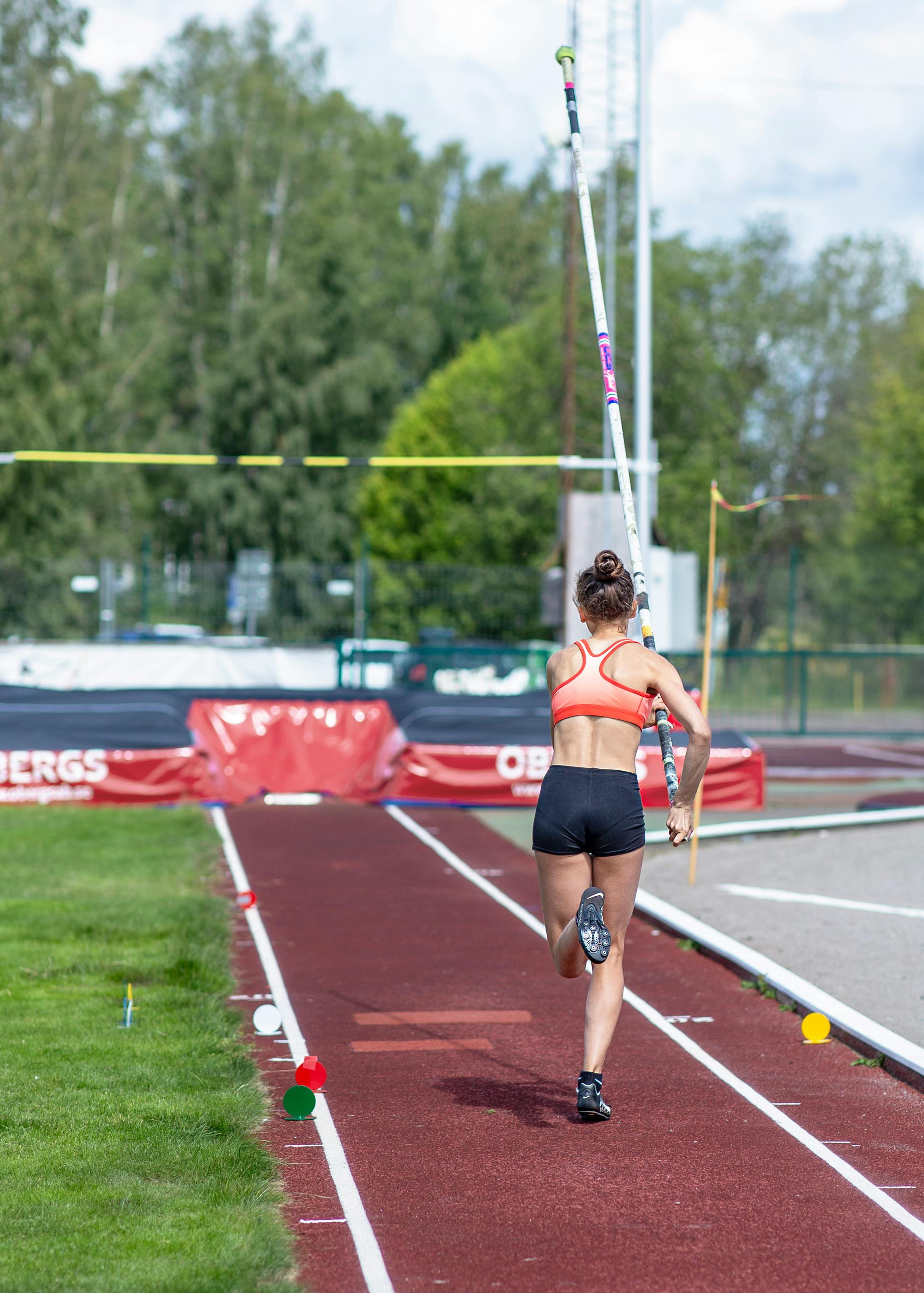Biomechanics of Pole Vaulting: Soaring to New Heights
In the world of track and field, few events captivate spectators quite like pole vaulting. This unique discipline combines raw power, precise technique, and a touch of aerial artistry. As athletes propel themselves skyward, defying gravity with a flexible pole, they push the boundaries of human potential. But what lies beneath this seemingly magical feat? Let's delve into the fascinating biomechanics that make pole vaulting possible.

The approach phase sets the stage for a successful vault. Vaulters typically cover a distance of 30-40 meters, gradually accelerating to reach their maximum controllable speed. This run-up is not just about velocity; it’s about building momentum while maintaining the perfect rhythm for the plant. The final few strides are critical, as the vaulter prepares to transfer their horizontal momentum into vertical lift.
As the pole is planted, the vaulter’s body position becomes paramount. The ideal angle of the pole at plant is around 30 degrees from vertical, allowing for optimal energy storage. The athlete’s arms should be fully extended, with their top hand positioned as high as possible on the pole. This high grip maximizes the potential height of the vault.
The Bend and Drive: Harnessing Elastic Energy
The moment of pole bend is where the magic truly begins. As the vaulter’s body weight and forward momentum compress the pole, it bends like a giant spring, storing elastic potential energy. The amount of bend is influenced by factors such as the vaulter’s speed, body weight, and the stiffness of the pole.
During this phase, the vaulter must maintain a straight body position, resisting the urge to break at the hips. This straight body acts as a lever, allowing for more efficient energy transfer from the pole to the athlete. As the pole begins to unbend, the vaulter initiates the drive phase, actively pushing against the pole to accelerate upward.
The timing of the drive is critical. Too early, and the vaulter may push themselves away from the bar; too late, and they miss the opportunity to gain maximum height. Elite vaulters often describe this moment as a feeling of weightlessness, where they’re working in harmony with the pole’s recoil.
The Turn and Fly: Defying Gravity
As the vaulter ascends, they must execute a complex series of movements to position themselves for clearing the bar. This includes a rapid turn of the body, transitioning from a vertical position to horizontal. The turn is initiated by the lower body, with the legs swinging upward and over the vaulter’s head.
During this phase, the athlete’s core strength comes into play. A strong core allows for better control and a more efficient turn. The arms play a crucial role as well, pushing off the pole at the precise moment to maximize height and distance over the bar.
The final moments of the vault involve extending the body fully, reaching upward with the arms and arching the back to clear the bar. This extension not only helps in clearing higher heights but also creates a visually stunning moment that defines the sport of pole vaulting.
Biomechanical Challenges and Adaptations
Pole vaulting places unique demands on the human body. The extreme forces experienced during the plant and bend phases can exceed 4-5 times the vaulter’s body weight. This requires not only strength but also proper technique to distribute these forces safely.
The shoulders and upper body bear much of this load, necessitating specific strength training. Vaulters often incorporate exercises that mimic the pulling and pushing motions of the vault, such as rope climbs and gymnastic ring work.
The lower body, particularly the legs and core, must be equally strong to generate the necessary speed and maintain body position throughout the vault. Plyometric exercises and Olympic lifts are common in vaulters’ training regimens, developing explosive power and coordination.
Technological Advancements in Pole Design
The evolution of pole technology has played a significant role in the advancement of pole vaulting performances. Early poles were made of solid wood, limiting the amount of bend and energy storage possible. The introduction of bamboo poles in the early 20th century allowed for greater flexibility and higher vaults.
The real revolution came with the development of fiberglass and carbon fiber poles in the 1950s and 60s. These materials offered unprecedented flexibility and strength, allowing vaulters to bend the pole much further without breaking. This increased energy storage potential translated directly into higher jumps.
Modern poles are carefully engineered to match the specific needs of each vaulter. Factors such as the athlete’s weight, run-up speed, and grip height are all considered when selecting or customizing a pole. The stiffness of the pole can be fine-tuned to optimize performance, with elite vaulters often traveling with a range of poles to adapt to different conditions.
Training Techniques for Optimal Performance
Developing the skills necessary for elite pole vaulting requires a multifaceted approach to training. Beyond the physical aspects, vaulters must hone their spatial awareness and timing. Many incorporate gymnastics and acrobatics into their training to improve body control and air awareness.
Visualization techniques are also crucial. Vaulters often spend time mentally rehearsing each phase of the jump, from the approach to the clearance. This mental preparation helps in perfecting timing and building confidence.
Video analysis has become an invaluable tool in modern pole vaulting training. Coaches and athletes use slow-motion footage to analyze every aspect of the vault, from the angle of the plant to the positioning during the turn. This detailed feedback allows for precise adjustments to technique.
The Role of Flexibility and Range of Motion
Flexibility plays a more significant role in pole vaulting than many might realize. A greater range of motion, particularly in the shoulders and hips, allows vaulters to achieve more extreme positions during the vault. This can translate into higher grips on the pole and more efficient energy transfer.
Specific stretching routines targeting the shoulders, back, and hips are a staple in vaulters’ training. Dynamic flexibility work is often incorporated into warm-up routines, preparing the body for the extreme ranges of motion experienced during vaulting.
Psychological Aspects of Pole Vaulting
The mental game in pole vaulting is as crucial as the physical. Vaulters must overcome the natural fear of launching themselves high into the air, trusting in their technique and equipment. Building this confidence is a gradual process, with athletes progressively increasing heights as they become more comfortable.
Concentration and focus are paramount. The approach run requires precise stride patterns, and any lapse in concentration can throw off the entire vault. Many vaulters develop pre-jump routines to center themselves and enter the optimal mental state for performance.
Injury Prevention and Management
Given the high forces and complex movements involved in pole vaulting, injury prevention is a critical aspect of training and performance. Common issues include shoulder injuries from the plant and bend phases, as well as back and knee problems from the landing.
Proper technique is the first line of defense against injuries. Coaches emphasize correct form from the earliest stages of training, ensuring that athletes develop habits that protect their bodies. Strength training, particularly of the core and stabilizing muscles, plays a crucial role in injury prevention.
Landing technique is also a focus area. While modern landing pits are designed to absorb impact, vaulters must still learn to land safely, distributing the force of impact and avoiding awkward positions.
The Future of Pole Vaulting Biomechanics
As our understanding of biomechanics and human physiology advances, so too does the potential for improvement in pole vaulting technique and performance. Research into muscle activation patterns and energy transfer efficiencies continues to refine training methods and technique.
Emerging technologies such as motion capture and force plate analysis provide increasingly detailed data on every aspect of the vault. This information allows for micro-adjustments to technique that can make the difference between clearing the bar and knocking it off.
The integration of sports science and biomechanics into pole vaulting training is likely to accelerate in the coming years. We may see more personalized training programs based on individual biomechanical profiles, optimizing each athlete’s natural strengths and addressing weaknesses.
The Art and Science of Defying Gravity
Pole vaulting remains one of the most visually stunning and technically complex events in track and field. The interplay of physics, biomechanics, and human determination creates a spectacle that continues to push the boundaries of what’s possible.
As we’ve explored, success in pole vaulting is a delicate balance of power, technique, and timing. From the energy conversion of the approach and plant to the aerial acrobatics of the turn and fly, every phase of the vault requires precise execution and years of dedicated training.
The ongoing advancements in our understanding of the biomechanics involved promise an exciting future for the sport. As athletes and coaches continue to refine techniques and training methods, we can expect to see even more breathtaking performances in the years to come.
Pole vaulting serves as a testament to human ingenuity and physical capability. It reminds us that with the right combination of scientific understanding, technological innovation, and sheer human will, we can indeed touch the sky.





